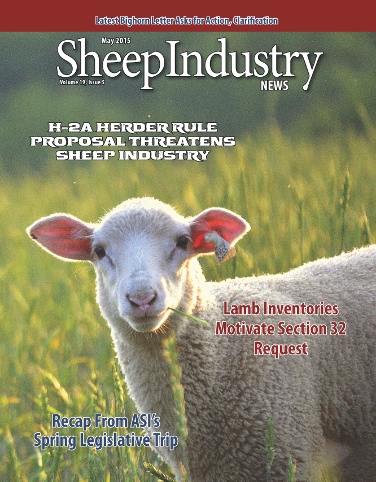
- May 2015
- President’s Notes
- Market Report
- USDA Meetings Yield Progress
- Inventories Motivate Section 32 Request
- Bighorn Letter Asks for Action, Clarification
- H-2A Proposal Calls for Extreme Wage Hikes
- News Briefs
- LRP-Lamb Expected to be Made Available in May
- Livestock Protection Dog Liability Insurance Survey
- NSIP Moving Forward
- A Standoff Approaches
- New Mill, Historic Location
- Producers Encouraged to Educate, Report, Submit
- Eight is Enough
- U.S. Hosiery Manufacturers Could Boost Market
Bighorn Letter Asks for Action, Clarification
U.S. Sen. John Barrasso (WY) and the House’s Western Caucus circulated a letter in April asking the USDA and the U.S. Department of Interior to address questions and concerns about potential losses of domestic sheep grazing allotments due to the bighorn sheep issue.
A similar letter to USDA Secretary Tom Vilsack and Secretary of the Interior Sally Jewell was sent in June 2014.
“We write to repeat our request for steps focused on finding solutions that prevent further loss of the domestic sheep industry and setbacks in the conservation of wild sheep,” the letter begins, noting appreciation for the response of the initial letter. “However, multiple questions and concerns were not addressed in your responses and there continues to be a general lack of clarity on the issue.“
The letter, which was being circulated in the nation’s capital in mid- April, was part of an ongoing effort to protect domestic sheep grazing on public lands and, ultimately, the future of the sheep industry. The Western Caucus, led by its chairperson Rep. Cynthia Lummis (WY), was actively seeking members of the House to sign the letter. ASI encouraged sheep producers and those in the industry to ask respective Senator s and Representatives to join in the campaign.
Specifically, the letter suggested that the U.S. Forest Service hold public forums to present maps of presumed bighorn sheep “risk” areas, levels of acceptable risk, and encourage public discussion of how these areas and levels were identified, which areas pose the greatest actual risks, and what options are available to eliminate those risks.
Last summer’s letter suggested placing potential alternative allotments on the rescissions schedule in order to fulfill any requirements and compliance with the National Environment Policy Act (NEPA). “Our previous letter also suggested the [Forest Service] not remove grazing permittees from their existing sheep grazing allotments until alternative allotments have been identified and made available, if domestic sheep operators are to be relocated,” the new letter states. “We believe the proper NEPA, environmental and procedural analysis should be completed before relocation occurs.”
Of concern to the sheep industry is the fact that responses from USDA and DOI is any indication what the federal agencies are doing to make alternative domestic grazing allotments available. “We cannot determine whether the departments even have a reliable method for identifying the entire set of allotments from which they can determine which are suitable for sheep grazing and why or why not,” the letter explains.
In a November 2014 response to the initial letter, USDA Under Secretary Robert Bonnie acknowledged that “the Washington Office will be working with Regional Foresters to help National Forest managers find alternative allotments that are suitable for domestic sheep use.”
The sheep industry and the Western Caucus are asking for more specifics, including confirmation that Forest Service managers are reviewing all suitable allotments, including those that have been closed for reasons that would be unaffected by sheep grazing if reopened. The information, they maintain, is necessary “to ensure all options for successful transition are considered and that alternative allotments can be found with similar forage types and amounts, in reasonable proximity to current allotments, and in compliance with federal grazing standards before relocation occurs.”
A point highlighted in both letters sent to USDA and the DOI involves internal practices and communications within the federal agencies – most notably a seemingly lack of collaboration with the Agricultural Research Service (ARS) in analyzing disease transmission. “ARS is the lead scientific research agency for USDA, yet neither of your letters mentioned ARS’ involvement in addressing issues facing domestic sheep and bighorn sheep,” the new letter states, referring to the responses last year by USDA and DOI. “As you are well aware, the reports that accompanied the Fiscal Year 2014 and Fiscal Year 2015 Agriculture and Interior appropriations bills contained congressional guidance specifically directing USFS collaboration with ARS.”
The latest letter then asks a direct question: “How are your departments complying with congressional direction?”
A November response brief submitted by the USDA and the Wilderness Society stated that ARS, “does not have special expertise with respect to the wildlife and habitat-management issue before the Forest Service.”
That brief went on to claim that there was no indication that wildlife protection, wildlife disease, and wildlife habitat issues are within the agency’s expertise. The brief also noted that while the Agricultural Research Service plainly has scientific expertise on many agricultural issues, it is not the go-to research service for scientific questions relating to wildlife; that is the Forest Service.
Seeking clarification, the new letter to the federal agencies inquires, “In the case of the USDA, is the appellee response brief the official USDA position with respect to ARS research?”
In conclusion, the letter circulated in April states that scientific contributions should not be limited to a single USDA agency.
“Domestic sheep are not wildlife,” the letter notes. “The Forest Service should be welcoming, not discouraging domestic sheep expertise from within USDA. Not only does ARS have needed scientific contributions on this issue, but state fish and wildlife agencies also have management responsibility for wildlife.

